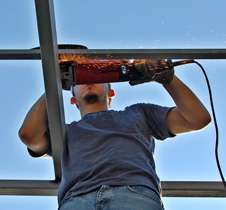NZ outdoor workers poorly protected from the sun, researchers find

New Zealand outdoor workers are generally poorly protected from solar UV radiation, with only around one-third wearing sunscreen or a suitably protective hat, according to a University of Otago study published in the latest issue of the international Journal of Occupational Health.
The study's findings also indicate that collective workplace action may be the key to reducing harmful sun exposure and associated skin cancer risk.
The research is the largest New Zealand study of its kind and surveyed the sun-protective practices, equipment provision and workplace culture of more than 1,000 workers across nine outdoor occupational groups. Outdoor workers make up nearly 15 percent of the New Zealand workforce.
Study lead author Associate Professor Tony Reeder says the findings showed that the average levels of personal sun protection were poor across all nine groups (forestry, roading, sawmilling, postal delivery, viticulture, landscaping, construction, horticulture, and farming).
Personal protection was scored on practices such as wearing hats, shirts, other protective clothing, sunglasses, and sunscreen. Hat wearing was the most commonly reported protective practice, but only one-third of hats worn were types that shaded the face, neck and ears. The two least common practices were using moveable shade structures and limiting sun exposure between 10am and 4pm.
"After adjusting for the demographic make-up of the groups, we found that forestry, horticulture, construction and farming were the sectors with the lowest average personal sun protection scores. Viticulture was the highest scoring group, but still only managed 3.2 out of a possible score of 8," Associate Professor Reeder says.
Aside from workers' awareness of how easily their skin tended to burn, there was no significant link between their sun-protection knowledge and personal protection scores, he says. Attitudes towards tanning were only relatively weakly associated with actual protective practices.
"However, we found good evidence that employees were more likely to protect themselves if their workplaces provided sun-protective equipment and supported and promoted its use."
The findings suggest that significant improvements are unlikely to be achieved by educational strategies alone, says Dr Reeder.
"Our research suggests that workplaces need to lead the way by providing appropriate protective gear and promoting a collective culture in which sun protection is seen as a priority," he says.
Currently, skin cancer accounts for about 80 percent of new cancers registered in New Zealand each year, or 70,000 cases. Around 2,000 are melanoma, which represents one of the highest rates in the world, and more than 400 New Zealanders die of skin cancer each year.
Associate Professor Reeder says that, given the burden that skin cancer places on the health system and the toll it takes on sufferers, it is time to get serious about limiting harmful occupational exposure to ultraviolet radiation.
To help further this, he and colleague Bronwen McNoe made a Cancer Society Social & Behavioural Research Unit submission to the NZ Independent Taskforce on Workplace Health & Safety seeking to require this exposure to be addressed by the development of a SunSmart culture in the workplace.
"This is a basic health and safety issue for outdoor workers and New Zealand really needs to do better in this regard."















